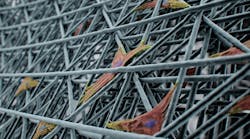A new way of 3D printing scaffolding for biological cultures developed at MIT could make it possible to grow cells that are uniform in shape and size. The new approach uses an extremely fine-scale form of 3D printing, using an electric field to draw fibers one-tenth the width of a human hair.
How a cell functions is influenced by its environment, so a scaffold that allows precise control over that environment may let researchers create cells with particular characteristics for research or eventually even medical use.
Although ordinary 3D printing create filaments as fine as 150 microns (millionths of a meter), it’s possible to get fibers down to widths of 10 microns by adding a strong electric field between the extruding nozzle and the stage on which the structure is being printed. The technique is called melt electrowriting.
If you take cells and put them on a conventional 3D-printed surface, it’s like a 2D surface to them because the cells themselves are so much smaller, according to an MIT researcher. But in a mesh-like structure printed using electrowriting, the structure is at the same scale as the cells, so their sizes and shapes and the way they stick to the structure can be controlled by adjusting the porous microarchitecture of that printed lattice structure.
The team used confocal microscopy to watch cells grown in various configurations of fine fibers—some random, some precisely arranged in meshes of different dimensions. The printing material is a polymer melt already approved by the FDA. The images were analyzed and classified using AI to correlate cell types with their variability and microenvironment.
Cells form proteins known as focal adhesions where they attach themselves to the structure. They are how cells communicate with their external environment. Measuring those adhesions lets researchers quantify them and use them to model and classify individual cell shapes.
The team found that cells acquire shapes directly corelated with the substrate’s architecture and the electrowritten substrates. The cells have much greater uniformity compared to nonwoven, randomly structured substrates. Uniform cell populations could be used in biomedical research because cell shape governs cell function and this work suggests a shape-driven pathway for consistently engineering and quantifying cell responses.
In recent work, the team has shown that certain types of stem cells grown in 3D-printed lattices survived much longer without losing their properties than those grown on conventional two-dimensional substrates. Thus, there may be medical applications for such structures, perhaps as a way to grow large quantities of human cells with uniform properties for transplantation or building artificial organs.
Tighter control over function is a major challenge in tailoring cells for specific cures or therapies. Any steps to tighten specifications on the scaffold, and thereby tighten the variations in cells are needed by this industry, according to the MIOT team. However, the printing method may have other applications. For example, it might be tweaked to print “metamaterials,” synthetic materials with layered or patterned structures with exotic optical or electronic properties.

